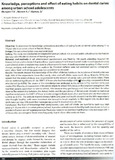| dc.contributor.author | Mungure, EK | |
| dc.contributor.author | Mutave, RJ | |
| dc.contributor.author | Opinya, GN | |
| dc.date.accessioned | 2013-02-21T16:04:19Z | |
| dc.date.issued | 2011 | |
| dc.identifier.citation | Journal of the Kenya Dental Association 2011;1 :141-144 | en |
| dc.identifier.uri | http://erepository.uonbi.ac.ke:8080/xmlui/handle/123456789/10657 | |
| dc.description | Pattern and clinical characteristics of firearm injuries. | en |
| dc.description.abstract | Objective: To determine the knowledge, perceptions and effects of eating habits on dental caries among 11 to 14 year olds in an urban school in Nairobi, Kenya.
Oesign:This was a descriptive cross sectional study
Setting: The study was conducted at Hospital Hill primary school. It is a co-ed public school run by the Nairobi City Council in Westlands division of Nairobi province.
Materials and methods: A self administered questionnaire was filled by 198 pupils attending Hospital Hill Primary School, and in classes 5-8 and a clinical examination ofthe first permanent molar in each quadrant using a periodontal probe or explorer was done in a fluorescent lit room. A tooth was noted as carious if it had a color change, wedging and catching of an explorer tip. Proximal surfaces were not examined and no radiographs were taken. Teeth with white spots were not considered as decayed.
Results: The results showed that knowledge of the effect of dietary habits on the incidence of dental caries was high, 99% of the respondents knew that candy, cakes and soft drinks cause tooth decay. Majority (93%) also agreed that the extent of decay was proportionate to the amount of candy, cakes and soft drinks taken. There was no statistical significance in the DMFT of those who had knowledge ofthi lationship compared to those who did not (p=0.896). The source of this knowledge was attributed to the dentist (47%), teachers (32%) and media (9%). Majority of respondents (198) carried snacks to school; 56% because they enjoyed eating them,19% had their parents pack them to take to school, 10% because they got hungry and 15% carried them for other reasons.The relationship between the dietary habits and the prevalence of dental caries showed no statistical significance between the DMFT of those who ate cariogenic foods more often and those who ate them once in a while (p=0.573). The attitude towards dietary habits and good oral health showed that the 99% respondents who thought healthy teeth were important also tended to brush regularly. In this regard 53% brushed their teeth twice per day, 24% more than twice per day and 21 % brushed once per day.
Conclusion: The level of knowledge that candy/sweets, cake and soft drinks are harmful to teeth was high among 9-16 year olds in an urban primary school. A positive attitude towards healthy teeth was shown to have a positive influence on oral hygiene practices. There was however no statistical significance in the first molar DMFT of those who ate cariogenic foods more frequently than in those who rarely ate them. | en |
| dc.language.iso | en | en |
| dc.relation.ispartofseries | Journal of the Kenya Dental Association 2011;1 :141-144; | |
| dc.title | Knowledge, perceptions and effect of eating habits on dental caries among urban school adolescents | en |
| dc.type | Article | en |
| local.embargo.terms | 6 months | en |
| local.publisher | 1. Kenyatta National Hospital | en |
| local.publisher | Department of Periodontology, Community and Preventive Dentistry, University of Nairobi | en |
| local.publisher | Department of Pediatric dentistry and Orthodontics, School of Dental Sciences, University of Nairobi | en |

